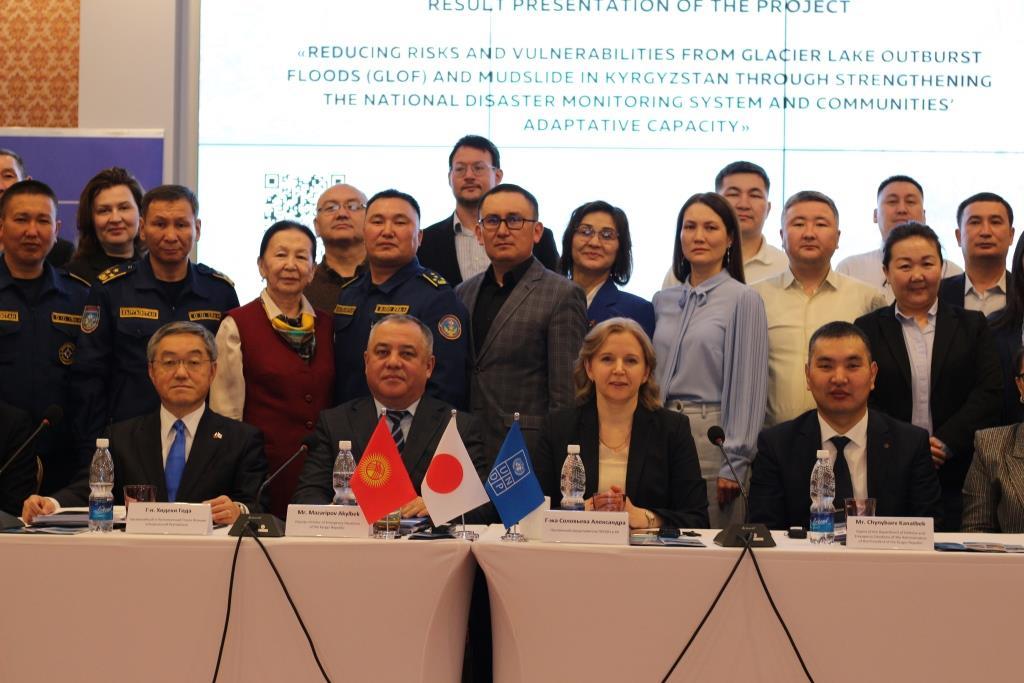Building Kyrgyzstan's resilience to natural disasters. UNDP, the Government of Japan and the Kyrgyz Ministry of Emergency Situations present the results of a key project to reduce the risks of glacial lake outburst
March 26, 2024, 23:18
Bishkek, 27 March 2024 - The results of a joint project by UNDP and the Ministry of Emergency Situations, funded by the Government of Japan, to reduce risks and vulnerability related to glacial lake outburst and mudslides in Kyrgyzstan were presented today. The event brought together representatives of ministries and agencies, scientific institutions working on high mountain lake issues, and other stakeholders to summarize the project's achievements.
The project has developed a unique information system for monitoring breakthrough lakes, equipped with proprietary algorithms based on machine learning. This will effectively prevent or minimize damage from natural disasters, especially glacial lake outbursts and mudslides, and improve the accuracy and efficiency of flood and mudslide forecasting.
Akylbek Mazaripov, Deputy Minister of Emergency Situations of the Kyrgyz Republic, said: "Strengthening the national disaster monitoring system is a key factor in improving our emergency preparedness. Thanks to the support of UNDP and the Government of Japan, we have made significant progress in this area".
Hideki Goda, Ambassador Extraordinary and Plenipotentiary of Japan to the Kyrgyz Republic, said: "Kyrgyzstan is one of the most vulnerable countries to the effects of climate change. Glacial lake outbursts can pose humanitarian, social, economic, environmental and political risks. The Government of Japan recognizes the importance of developing a sustainable society in close cooperation".
Alexandra Solovieva, UNDP Resident Representative in the Kyrgyz Republic, said: "This project is an important step towards ensuring sustainable development and human security in Kyrgyzstan. Thanks to our cooperation, we have been able to significantly improve the country's capacity to prevent and respond to natural disasters".
Kanatbek Chynybaev, an expert from the Situation Center of the Presidential Administration of the Kyrgyz Republic, noted: "It is encouraging to see that the results of this project directly meet the requirements of the National Development Program of the Kyrgyz Republic 2026, which reflects that addressing disaster risk reduction in a changing climate should be comprehensive, taking into account future threats and hazards, the development of new methods of forecasting and response".
The project has achieved significant results in three key areas:
1. Development and Approval of the National Action Plan:
The project developed a National Action Plan 2030 that aims to improve the national capacity to monitor and forecast natural disasters and mudslides. The plan includes a comprehensive analysis of Kyrgyzstan's current monitoring and forecasting systems. It also includes the establishment of an automated system for monitoring high mountain lakes and the design of a unified integrated monitoring and forecasting system that will operate until 2030.
2. Strengthening National Disaster Risk Reduction (DRR) Capacity:
The second key outcome was the strengthening of national capacity to manage risks related to glacial lake outbursts. This was achieved by upgrading and integrating software and hardware with access to satellite data into the national disaster monitoring system. Improvements were made to the unified information system for lake monitoring, including the introduction of innovative approaches such as machine learning algorithms, multi-parameter analysis and predictive systems for risk assessment.
3. Increased adaptive capacity of local communities:
The third major outcome of the project is to strengthen the capacity of local communities to adapt to the risks of glacial lake outburst and landslides. This was achieved through a participatory approach that included training residents in the pilot communities (Cholpon-Ata town, Chon-Sary-Oy and Bosteri aiyl aimaks) in preventive measures, developing and improving local disaster risk reduction plans, and implementing practical activities such as constructing protective structures. An information campaign was also conducted to raise public awareness of natural hazards.
The third component of the project was implemented by the International Public Foundation Roza Otunbaeva Initiative.
In summary, the results of the project, implemented with the financial support of the Government of Japan and the efforts of UNDP, were a significant step in strengthening Kyrgyzstan's resilience to natural disasters. Based on the successful implementation of advanced technologies and an improved emergency response system, the project has significantly strengthened the national capacity to monitor and forecast potential hazards. This achievement not only improved the safety of the Kyrgyz population, but also made an important contribution to regional and global efforts to adapt to climate change and reduce disaster risk.
The project "Reducing Risks and Vulnerabilities from Glacial Lake Outburst Floods (GLOF) in Kyrgyzstan through Strengthening the National Disaster Monitoring System and Communities' Adaptive Capacity" aims to minimize risks and vulnerabilities associated with potential disasters caused by glacial lake outburst floods and subsequent flooding, while protecting local communities. The project was made possible through the Climate Promise initiative with financial support from the Government of Japan through the United Nations Development Program (UNDP).
Media Contacts:
Ainagul Abdrakhmanova, UNDP Public Affairs Chief +996775755776